ATO’s draft thin cap rules miss the mark, fuel uncertainty: CA ANZ

Proposed Tax Office guidance classifies routine refinancing as “high-risk”, according to the body’s recent submission.
The ATO’s proposed guidelines around debt deduction may raise uncertainty for taxpayers and ensnare “ordinary” refinancing efforts, undermining the thin capitalisation regime’s intent, CA ANZ has warned.
In a recent submission, the accounting body raised several “concerns” with PCG 2024/D3, detailing the ATO’s proposed compliance approach to restructures and the thin capitalisation and debt deduction creation rules (DDCR).
“There appears to be a disconnect between the intended target of the relevant integrity provisions in relation to restructures carried out in response to the DDCR … and the draft PCG’s classification of the examples in the various risk zones and ATO compliance approach,” the submission said.
Debt deduction creation rules were introduced under the Treasury Laws Amendment (Making Multinationals Pay Their Fair Share - Integrity and Transparency) Act 2023.
For income years that commence on or after 1 July 2024, the DDCR operates to disallow excessive related-party debt deductions for certain related-party arrangements of multinational businesses, including private businesses and privately owned groups.
The draft PCG divides restructuring activities into green, yellow and red risk zones, indicating the likelihood of ATO scrutiny.
But CA ANZ said “restructuring” was defined too “expansively”, including any refinance, any change or reorganisation of group structure, business affairs or financial arrangements.
It meant businesses’ “ordinary” transactions or restructures carried out to comply with the legislation that did not create additional deductions were caught up in the regime.
“Our members have expressed concerns with the draft PCG’s approach to classifying restructuring types across the various risk zones,” CA ANZ said.
“We are concerned with the classification of the simple restructure of replacing related party debt with third-party debt as high risk … this is an ordinary commercial dealing.”
“Due consideration should be given to including additional or clarified examples that clearly address restructures that are carried out in order to comply with the intention of the new law and are classified as low risk because, for example, there is no net increase in debt or ‘creation of’ debt deductions.”
CA ANZ added that most restructuring arrangements would likely fall into the “yellow zone,” triggering ATO review.
It argued this would increase uncertainty when the role of PCGs was to ease practical challenges associated with tax law.
“Rather than guiding taxpayers on clear risk distinctions, without certain changes, it may instead increase uncertainty around the likelihood of ATO compliance activity across a wide spectrum of restructuring activities,” it said.
CA ANZ also called on the ATO to provide more examples of low-risk restructures, such as ordinary refinancing under commercial terms.
“We consider the draft PCG would be of greater utility if it covered one of the most common types of restructures that taxpayers undertake. That is, merely replacing related party debt with third party debt under ordinary commercial terms, where it is not undertaken in any artificial or contrived manner.”
Adopting a safe harbour or de minimis threshold for historical debts that might fall under the new rules would also reduce the regime’s compliance burden, CA ANZ said.
“The position under the draft PCG is that the onus is on the taxpayer to prove that the DDCR do not apply. The discharge of this onus can be achieved by providing information and documentation to the ATO … we consider this to be an overly stringent approach, especially for historical transactions,” it said.
“We therefore consider that due consideration should be given to adopting a safe harbour or de minimis approach within the draft PCG for such situations.”
About the author







